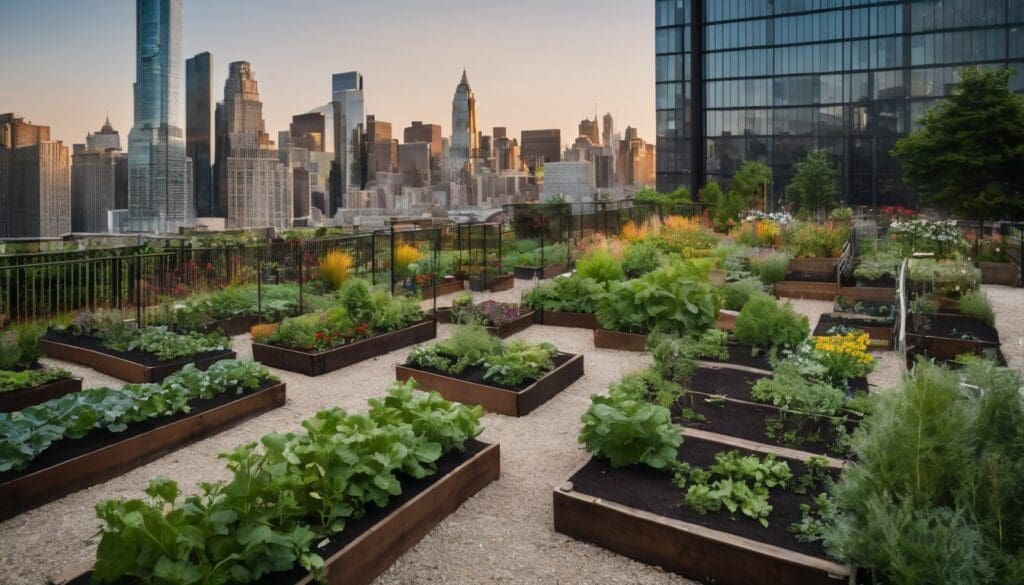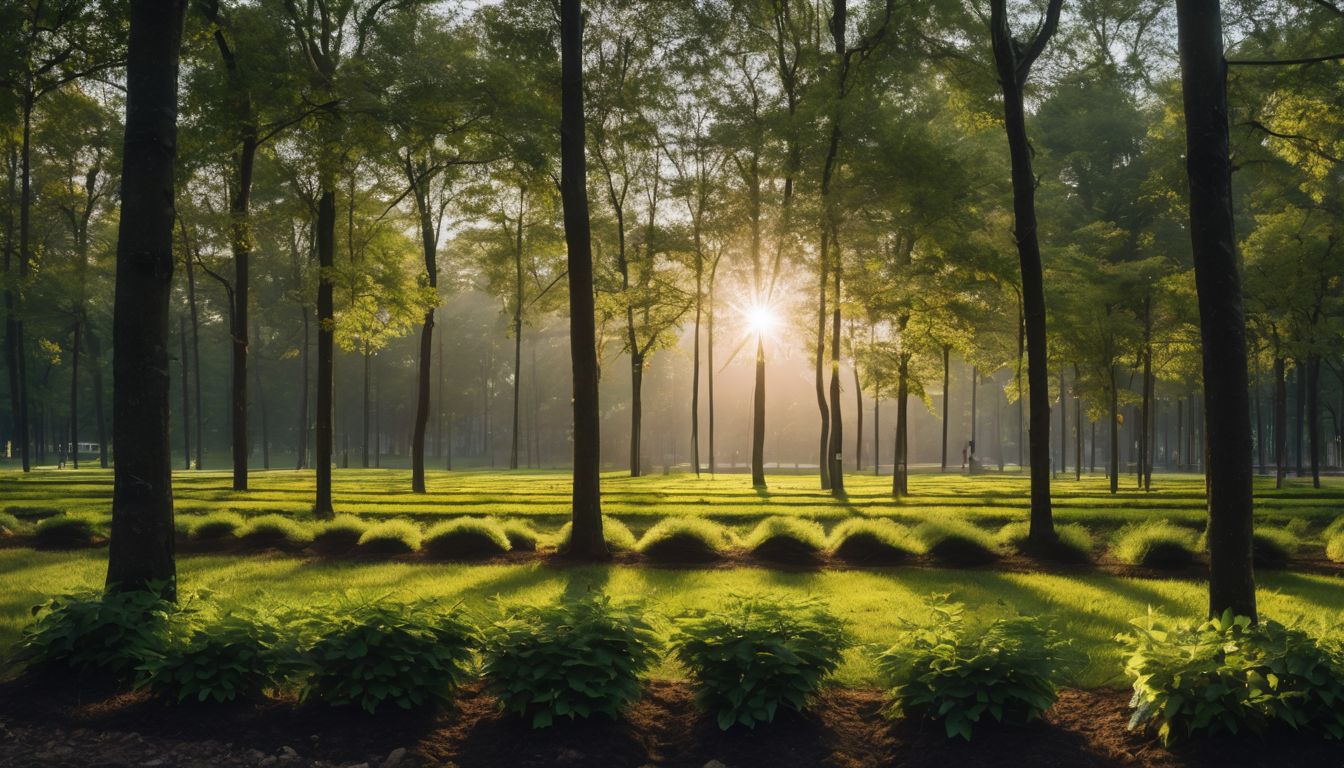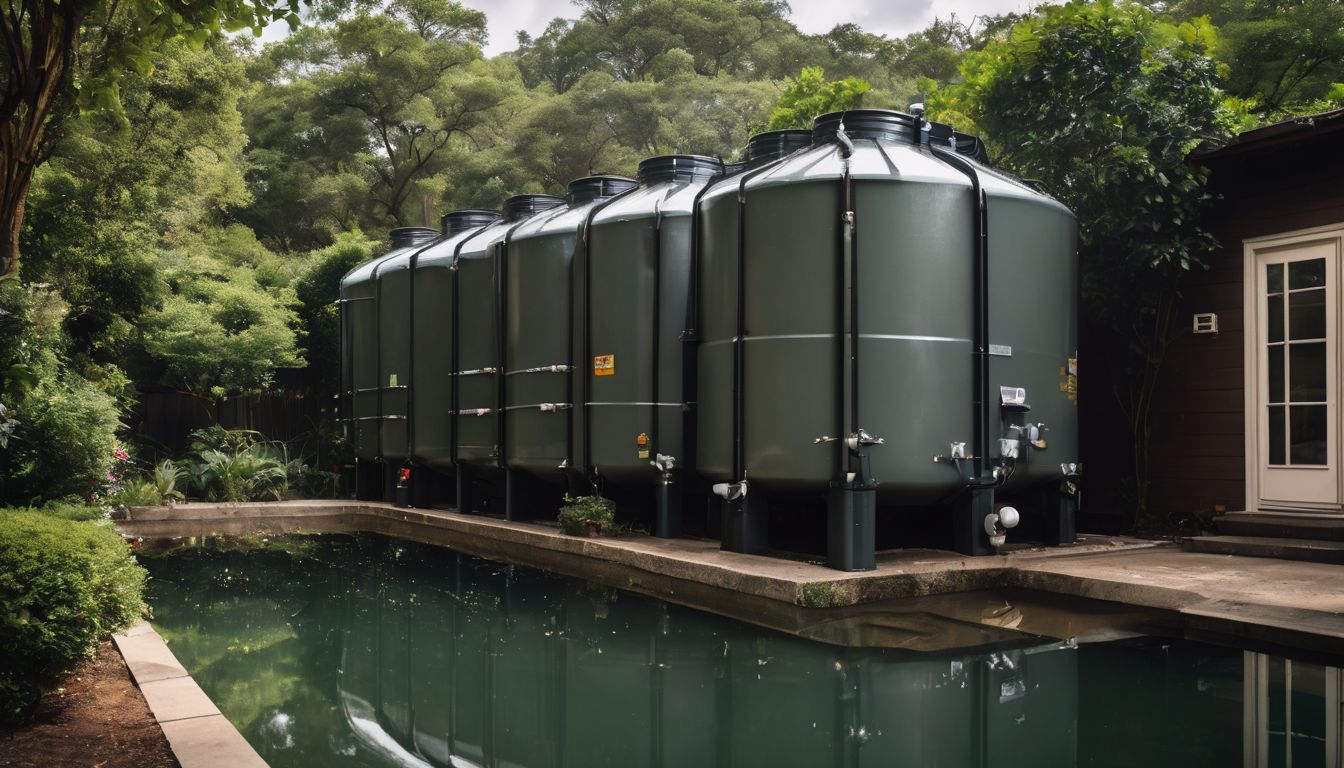Finding space for nature in our crowded cities can be tough. Green spaces are true game-changers, offering a raft of benefits from cleaner air to community well-being. This article is your guide to creating these vital spots, transforming concrete jungles into lush urban retreats.
Dive in and let’s get greening!
Key Takeaways
- Engaging communities in the visioning and goal – setting process is key to creating green spaces that reflect the needs and desires of local residents, promoting ownership and pride in these areas.
- Innovative urban green space concepts like mini-forests and urban food forests can boost biodiversity, provide fresh food, and strengthen community bonds by involving residents in greening initiatives.
- The Green Streets, Green Jobs, Green Towns approach integrates sustainable solutions into urban planning, helping manage stormwater runoff while creating jobs and improving quality of life.
- Overcoming implementation challenges such as funding limitations or bureaucratic obstacles is essential for the successful development of community green spaces that offer environmental benefits.
- Incorporating technology and entrepreneurship plays a crucial role in developing greener cities by introducing smart systems for sustainability alongside fostering economic growth through eco-friendly ventures.
Benefits of Community Green Spaces
Community green spaces provide numerous benefits, including environmental advantages such as improved air quality and reduced urban heat islands. They also offer socioeconomic benefits by enhancing property values and promoting community engagement and social cohesion.
Environmental benefits
Green spaces work like natural air filters in our towns and cities. They absorb pollutants, provide oxygen, and help to lower temperatures during hot spells. Trees and plants capture dust, smoke, and other harmful particles from the air we breathe.
This makes urban environments cleaner and healthier for residents.
Creating pockets of nature within concrete jungles also supports biodiversity by offering habitats for different species. Birds, insects, and small mammals find refuge in city parks and community gardens rich with varied flora.
These green havens become crucial stepping stones for wildlife navigating through urban landscapes often dominated by buildings and roads. Plus, the presence of diverse ecosystems enhances ecological resilience against pests or diseases that might otherwise spread unchecked in less biodiverse settings.
Sustainable landscaping practices ensure local waterways are protected from excess runoff during storms. Rain gardens can filter out pollutants before they enter rivers or lakes, safeguarding aquatic life as well as human health downstream.
Urban green spaces instil a greater sense of environmental stewardship — when people connect with nature where they live, they’re more likely to engage in conservation efforts on a broader scale.
Socioeconomic benefits
Community green spaces offer various socioeconomic benefits, fostering a sense of community and pride. They enhance property values, attracting potential buyers and benefitting local businesses.
Additionally, they create employment opportunities through maintenance and programming initiatives. Moreover, these spaces promote social interaction and cohesion among residents, reducing crime rates while improving mental health.
The presence of public green areas in urban settings stimulates economic growth by encouraging tourism and supporting nearby cafes and shops. Furthermore, the development of community green spaces contributes to a more sustainable urban environment, attracting new residents who value ecological living.
Equity considerations
Promoting equity in the development of community green spaces is crucial for ensuring that all members of the community have fair and just access to these valuable resources. It involves addressing disparities in access to public green areas, especially in urban settings.
This includes understanding the specific needs of diverse populations, including low-income neighbourhoods and marginalised communities, and actively involving them in the planning and decision-making processes related to sustainable urbanisation and ecological restoration efforts.
To achieve equitable outcomes, it is essential to consider socioeconomic factors such as income levels, cultural diversity, language barriers, and historical inequities when designing and implementing green infrastructure projects.
Connection to small and rural towns
Green spaces are vital in small and rural towns, contributing to community well-being. They offer natural recreational areas for residents to enjoy outdoor activities such as picnics, sports, and walks.
These green spaces also provide opportunities for communities to come together through events and gatherings. By integrating public parks and sustainable landscaping into these areas, small and rural towns can enhance their environmental conservation efforts while promoting a sense of belonging among residents.
Supporting biodiversity conservation is crucial in small and rural towns where natural reserves may be limited. Green urban planning that includes community open spaces encourages ecological design within these areas, fostering a sustainable environment for future generations.
Strategies for Implementing Community Green Spaces
Community visioning and goal setting, green streets and open spaces, collaboration with local organisations, and the use of the Green Streets, Green Jobs, Green Towns approach are all essential strategies in creating vibrant and sustainable community green spaces.
Read on to discover how these strategies can benefit your local area.
Community visioning and goal setting
To plan and implement community green spaces, it is essential to engage in community visioning and goal setting. This involves:
- Engaging with residents to understand their vision for green spaces and what they hope to achieve.
- Setting clear and achievable goals for the development of sustainable infrastructure in the community.
- Collaborating with local environmental organisations to align visions and set shared goals.
- Ensuring that the vision and goals are reflective of the diverse needs of the community, including equity considerations.
- Creating a long – term plan that considers environmental sustainability and community development.
Green streets and open spaces
Green streets and open spaces play a crucial role in providing environmental benefits to urban communities. Here are strategic approaches for integrating green streets and open spaces:
- Designing streets with vegetation, such as trees and bushes, to reduce heat island effect, improve air quality, and provide shade for pedestrians.
- Creating pocket parks and green corridors within cities to enhance biodiversity, mitigate flooding, and offer recreational areas for residents.
- Implementing permeable pavements that allow rainwater infiltration, reducing stormwater runoff and pollution.
- Incorporating urban agriculture initiatives like community gardens or rooftop farms to promote local food production and community engagement.
Collaboration with local organizations
Local organisations play a vital role in the planning and implementation of community green spaces. By partnering with these organisations, urban parks and outdoor recreational areas can be designed to meet the unique needs and preferences of local residents.
This collaboration fosters a sense of ownership within the community, ensuring that green spaces truly reflect the values and aspirations of the people they serve. Working together also allows for leveraging resources, whether it’s through funding, volunteer support, or expertise in environmental conservation.
Furthermore, collaborating with local organisations promotes social cohesion by bringing diverse groups together around a common cause: creating sustainable and accessible green spaces for all.
Use of the Green Streets, Green Jobs, Green Towns approach
Implementing the Green Streets, Green Jobs, Green Towns approach involves integrating sustainable and nature-based solutions into urban planning to enhance environmental quality. This strategy focuses on creating green infrastructure such as rain gardens and permeable pavements to manage stormwater, reduce pollution, and improve air quality in urban areas.
It also promotes the use of green spaces for recreation and community gatherings while supporting local economic development through the creation of green jobs in landscaping and conservation.
By adopting this approach, communities can address environmental challenges while fostering social connections and enhancing overall well-being.
Innovative Ideas for Urban Green Spaces
Explore creative concepts such as mini-forests and urban food forests to maximise green space in urban areas, whilst also participating in events like PARK(ing) Day to demonstrate the potential for transforming parking spaces into vibrant community hubs.
Mini-forests
Mini-forests are compact, biodiverse areas that mimic the structure and function of natural forests. These urban green spaces provide a range of benefits, including carbon sequestration, air purification, and wildlife habitat creation.
In addition to their environmental contributions, mini-forests offer opportunities for community engagement and education on ecological conservation. By incorporating native plant species and promoting sustainable land management practices, these small-scale ecosystems can play a significant role in enhancing urban biodiversity and mitigating the impacts of climate change.
Urban residents keen on supporting conservation efforts may find mini-forests an accessible way to participate in local greening initiatives. As such green spaces continue to gain momentum as integral components of sustainable urban planning strategies around the world.
Urban food forests
When considering innovative ideas for urban green spaces, urban food forests emerge as an exciting and sustainable concept. Urban food forests are community-managed and provide a variety of edible produce, such as fruits, nuts, herbs, and vegetables.
These multi-layered ecosystems not only offer access to fresh and nutritious food but also promote biodiversity and environmental resilience within urban settings. In addition to addressing food insecurity, urban food forests serve as valuable educational resources while fostering a sense of community ownership and collaboration in the cultivation of shared resources.
Integrating urban food forests into city landscapes presents an opportunity to reconnect individuals with nature while promoting sustainable living practices. By providing hands-on experiences in gardening and harvesting, these spaces have the potential to enhance local ecosystems, contribute to food sovereignty efforts, reduce the carbon footprint associated with food transportation, and strengthen community bonds through shared stewardship of natural resources.
Participating in PARK(ing) Day
Participating in PARK(ing) Day allows communities to creatively transform parking spaces into temporary green areas, bringing attention to the importance of urban green spaces. This event encourages people to rethink the potential uses of public space and promotes dialogue on sustainable and inclusive urban design.
By participating in PARK(ing) Day, individuals can play an active role in advocating for more accessible and environmentally friendly city landscapes.
The impact of participating in PARK(ing) Day extends beyond the event itself, sparking conversations about integrating green spaces into strategic urban planning and demonstrating the positive influence community-driven initiatives can have on creating a more sustainable future for cities.
Integration of Green Spaces in Strategic Planning
Incorporating greenery into urban planning and architecture helps create a more sustainable and environmentally-friendly cityscape. Read on to discover how these strategic initiatives can transform communities for the better.
Inclusion in urban planning
Urban planning plays a crucial role in integrating green spaces into the fabric of cities, ensuring that they are accessible and beneficial to all members of the community. This process involves identifying suitable locations for parks, recreational areas, and green corridors within urban landscapes, as well as incorporating sustainable design principles into new developments.
By actively involving local residents, city planners can better understand their needs and preferences when it comes to public green spaces, fostering a sense of ownership and community pride.
Moreover, urban planning enables the establishment of regulations and policies that support the preservation and expansion of green infrastructure, promoting biodiversity while mitigating environmental challenges such as air pollution and heat stress.
Blue-green areas
Inclusion in urban planning fosters the development of blue-green areas, creating a balance between built environments and natural landscapes. These spaces not only enhance aesthetics but also contribute to biodiversity conservation and sustainable urban drainage systems, minimising flood risk.
Integrating water features like ponds, wetlands, or green roofs into city design can mitigate heat island effects and provide recreational opportunities while promoting environmental awareness.
To thrive as environmentally conscious communities, embracing blue-green areas is vital for enhancing quality of life through improved air quality, reduced pollution levels, and increased resilience to climate change.
Incorporating greenery into architecture
Architects and urban planners are increasingly incorporating greenery into architecture to enhance the sustainability and aesthetic appeal of buildings. Green roofs, vertical gardens, and living walls are innovative solutions being integrated into modern architectural designs.
These features not only improve air quality in urban environments but also help reduce energy consumption by providing natural insulation. Additionally, integrating greenery into architecture supports local biodiversity and creates a more pleasant and enjoyable urban environment for residents.
Sustainable architecture with green design elements is crucial for addressing environmental challenges in today’s cities. By incorporating greenery into building structures, architects contribute to creating healthier and more environmentally-friendly communities while promoting a closer connection between urban spaces and nature.
Challenges and Opportunities for Green Spaces in Cities
Cities face various challenges in implementing green spaces, such as barriers to implementation and the need to combat heat islands. However, there are also opportunities for technology and entrepreneurship to create a sustainable future for urban communities.
Barriers to implementation
Implementing community green spaces can be met with various barriers, including limited funding and resources, lack of community engagement, and bureaucratic hurdles. Securing financial support for green space projects can be challenging, hindering the development of these vital areas.
Additionally, overcoming resistance from certain stakeholders who may not fully understand the benefits of green spaces can also pose a significant obstacle.
Furthermore, navigating through complex administrative processes and regulations often slows down or complicates the implementation phase. Overcoming these barriers requires proactive efforts to secure funding through grants and partnerships, actively engaging with local residents to build support and understanding, and effectively working with local authorities to streamline approval processes.
How to avoid heat islands
To avoid heat islands, incorporating green infrastructure into urban planning is crucial. Utilising light-coloured and reflective materials for pavements and roofs can help reduce the absorption of heat, while increasing vegetation through tree planting and green spaces can provide shade and cooling effects.
Implementing cool roof technologies on buildings and using permeable paving in car parks can also mitigate the urban heat island effect by reducing surface temperatures. Furthermore, promoting energy-efficient building designs that incorporate natural ventilation systems and reducing the use of heat-generating materials can contribute to creating cooler and more sustainable urban environments.
In addition to these measures, integrating water features like fountains or ponds within public spaces can help moderate temperatures through evaporative cooling while enhancing aesthetic appeal.
Technology and entrepreneurship for greener cities
To avoid heat islands, cities are increasingly turning to technology and entrepreneurship for greener solutions. Innovative technologies such as smart irrigation systems, green roofs, and vertical gardens are being embraced to reduce urban heat effects while promoting sustainability.
Additionally, entrepreneurs are creating eco-friendly products and services that contribute to the development of greener urban spaces. These initiatives not only combat climate change but also foster economic growth and job creation within urban communities.
Incorporating renewable energy sources like solar panels or wind turbines in city infrastructure is a key part of building greener cities. Collaborations between technology firms and local government can pave the way for the integration of sustainable practices into urban environments, ultimately leading to healthier and more environmentally friendly spaces for all.
Creating a sustainable future for urban communities
To ensure a sustainable future for urban communities, it is essential to prioritise the integration of green spaces into city planning. This can involve implementing policies that support the preservation and expansion of parks, gardens, and other natural areas within urban settings.
Additionally, initiatives such as promoting sustainable transportation options like walking and cycling paths contribute to reducing environmental impact while fostering healthier and more liveable cities.
Moreover, adopting modern technologies that mitigate environmental challenges in urban areas plays a vital role in creating sustainability. This includes investing in green infrastructure solutions like green roofs and permeable pavements to manage stormwater runoff effectively.
Conclusion
In conclusion, creating community green spaces provides numerous benefits. These spaces can enhance the environment and promote social and economic well-being. Implementing these strategies requires collaborative effort and innovative ideas to overcome challenges and create a sustainable future for urban communities.
FAQs
1. What are community green spaces?
Community green spaces are areas where people come together to enjoy nature, play, and relax in a shared outdoor environment.
2. Why is planning important for creating community green spaces?
Planning ensures that community green spaces meet the needs of all users and considers factors like location, design, accessibility, and maintenance for long-term success.
3. Who should be involved in implementing these green areas?
Everyone from local residents to council members should get involved to share ideas and help create a space that reflects the desires of the whole community.
4. Can volunteers help with maintaining our local green space?
Absolutely! Volunteers can join forces to keep the area clean, plant flowers and trees or even organise fun activities making sure the community’s green space thrives.





